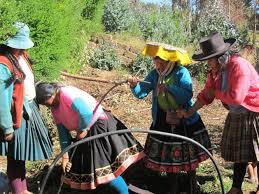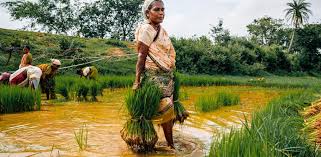Subsistence farming is an agricultural system where farmers focus on growing enough food to feed themselves and their families rather than for sale in the market.
This practice is often characterized by small-scale production, limited use of technology, and reliance on traditional methods. Subsistence farming is prevalent in many developing regions around the world and plays a crucial role in ensuring food security for millions of people.
1. Definition of Subsistence Farming: Subsistence farming involves producing food primarily for the farmer’s consumption, with little surplus for trade. This type of farming often includes a variety of crops and livestock, promoting self-sufficiency.
2. Characteristics of Subsistence Farming: Limited use of commercial inputs such as fertilizers and pesticides. Reliance on traditional farming techniques and local knowledge, A focus on diverse crops to meet nutritional needs, Small plots of land, often cultivated by family members.
Traditional Subsistence Farming Practices
Traditional subsistence farming practices have been passed down through generations and are closely linked to the cultural and environmental contexts of the communities that use them.
1. Crop Diversity: Farmers typically grow a variety of crops to ensure food availability throughout the year. This diversity helps reduce the risk of total crop failure due to pests or adverse weather conditions.
2. Agroecological Practices: Many subsistence farmers use agroecological methods, such as intercropping and crop rotation, to maintain soil fertility and control pests naturally. These practices are often based on centuries of knowledge about local ecosystems.
3. Livestock Integration: Livestock plays a vital role in traditional subsistence farming. Animals provide manure for fertilization, serve as a source of protein, and help with land preparation and transportation.
4. Seasonal and Cultural Calendars: Farmers often follow seasonal calendars that dictate planting and harvesting times, influenced by local climate patterns and cultural traditions. This connection to nature ensures that agricultural practices align with the environment.
Subsistence Farming in Africa

Subsistence farming is widespread in Africa, where many rural communities depend on agriculture for their livelihoods. The continent’s diverse climates and cultures contribute to a variety of farming practices.
1. Smallholder Farms: Most African subsistence farmers are smallholders who cultivate small plots of land, often less than two hectares. They rely on family labor and traditional practices to grow staple crops such as maize, sorghum, millet, and cassava.
2. Challenges Faced: African subsistence farmers often face challenges such as limited access to markets, climate change impacts, soil degradation, and inadequate infrastructure. These challenges hinder their ability to produce sufficient food and improve their livelihoods.
3. Community Support: Many communities have developed cooperative systems to support subsistence farming. These cooperatives help farmers access resources, share knowledge, and improve their market position.
4. Impact of Policy: Government policies can greatly affect subsistence farming in Africa. Supportive policies that promote sustainable practices and provide access to resources can help improve food security for rural populations.
Subsistence Farming in Asia
Asia has a long history of subsistence farming, which remains a vital source of food and income for many rural communities. The diversity of climates and cultures across the continent leads to various subsistence farming practices.
1. Rice Cultivation: In many Asian countries, rice is a staple food and a primary crop in subsistence farming. Farmers often grow rice in flooded fields, utilizing traditional irrigation methods.
2. Mixed Farming Systems: Asian subsistence farmers frequently practice mixed farming, combining crop production with livestock rearing. This integration helps enhance soil fertility and provides a diverse diet for families.
3. Technological Adoption: While traditional practices dominate, some regions in Asia have begun adopting modern technologies and practices to improve yields and sustainability. This includes the use of improved seed varieties, irrigation techniques, and organic fertilizers.
4. Urbanization Challenges: Rapid urbanization in Asia poses challenges to subsistence farming. As more people move to cities, rural populations may decline, leading to a reduction in agricultural production and increased food insecurity.
Read Also: How to Control Feeding Struggle among Fishes in the same Pond
Subsistence Farming in Latin America

Subsistence farming in Latin America is an integral part of the region’s agricultural landscape, providing food and livelihood for many rural families. The practice varies widely across different countries and climates, adapting to local conditions and cultural traditions.
1. Diverse Agricultural Practices: In Latin America, subsistence farmers often cultivate a range of crops, including maize, beans, potatoes, and various fruits and vegetables. This diversity not only meets the nutritional needs of the family but also helps protect against crop failure.
2. Indigenous Farming Techniques: Many subsistence farmers in the region employ indigenous techniques that have been passed down through generations. These methods are often based on sustainable practices, such as agroforestry, where crops and trees are grown together, benefiting both.
3. Community Cooperation: Subsistence farming in Latin America frequently involves community cooperation. Farmers may work together for mutual support, sharing resources, knowledge, and labor to enhance food security within their communities.
4. Urban Migration Impact: Like other regions, Latin America is experiencing urban migration, where rural populations are moving to cities for better opportunities. This migration can lead to a decline in subsistence farming, affecting food production and security in rural areas.
Subsistence Farming in Europe
While Europe is often associated with large-scale commercial agriculture, subsistence farming still exists, particularly in Eastern and Southern Europe. These practices are crucial for maintaining local food systems and cultural heritage.
1. Small Family Farms: Many European subsistence farms are small family-run operations that produce a variety of crops and livestock. These farms often focus on organic methods and sustainable practices, contributing to biodiversity and environmental health.
2. Agricultural Diversity: European subsistence farmers grow various crops, including vegetables, grains, and fruits, often using traditional techniques. This diversity supports local diets and contributes to regional culinary traditions.
3. Resilience to Economic Changes: Subsistence farming provides a safety net for families during economic downturns. By producing their own food, these farmers can reduce their reliance on market fluctuations and ensure their food security.
4. Support from Local Policies: Some European countries promote subsistence farming through policies that support small-scale agriculture and sustainable practices. This support helps maintain rural communities and preserves traditional farming knowledge.
Benefits of Subsistence Farming
Subsistence farming offers several benefits, both for the farmers and the communities in which they operate:
1. Food Security: By producing their own food, subsistence farmers ensure that they have access to fresh and nutritious produce, reducing their dependency on market fluctuations and external sources.
2. Economic Stability: Subsistence farming provides a steady source of income and can enhance the economic stability of rural families. It allows families to save money by reducing food expenses.
3. Cultural Preservation: Traditional farming practices contribute to cultural heritage and identity. By continuing these methods, communities preserve their knowledge, skills, and customs.
4. Environmental Sustainability: Subsistence farmers often use environmentally friendly practices that promote biodiversity, maintain soil health, and conserve water resources. These practices contribute to sustainable land use and environmental health.
Read Also: Complete Guide on Treatment of Livestock Diseases
Challenges Faced by Subsistence Farmers

Despite its benefits, subsistence farming faces several challenges that can hinder its effectiveness and sustainability:
1. Climate Change: Subsistence farmers are particularly vulnerable to climate change impacts, such as extreme weather events, droughts, and unpredictable rainfall. These changes can threaten crop yields and food security.
2. Limited Access to Resources: Many subsistence farmers struggle with limited access to resources, including land, credit, and technology. This lack of support can impede their ability to improve productivity and income.
3. Market Access: Subsistence farmers often face challenges in accessing markets to sell surplus produce. This limited market access reduces their income potential and makes it difficult to invest in their farming operations.
4. Health and Nutrition Issues: Subsistence farmers may struggle with health and nutrition issues, particularly if their diets lack diversity. Limited access to healthcare and education can also impact their well-being and productivity.
Subsistence farming remains a vital practice in many regions around the world, including Latin America and Europe. While it offers numerous benefits, such as food security, economic stability, and cultural preservation, it also faces significant challenges.
Subsistence farming is a fundamental aspect of food production in many regions around the world, particularly in Africa and Asia.
Addressing these challenges through supportive policies and resources can help strengthen subsistence farming and enhance food security for millions of people globally.
By understanding the traditional practices and challenges faced by subsistence farmers, we can better appreciate the importance of these systems in ensuring food security and promoting sustainable agriculture.
Supporting these farmers through policies and programs that address their unique needs will be crucial for the future of global food systems.
Do you have any questions, suggestions, or contributions? If so, please feel free to use the comment box below to share your thoughts. We also encourage you to kindly share this information with others who might benefit from it. Since we can’t reach everyone at once, we truly appreciate your help in spreading the word. Thank you so much for your support and for sharing!
Read Also: Underground Water and Aquifers
Frequently Asked Questions
We will update this section soon.

